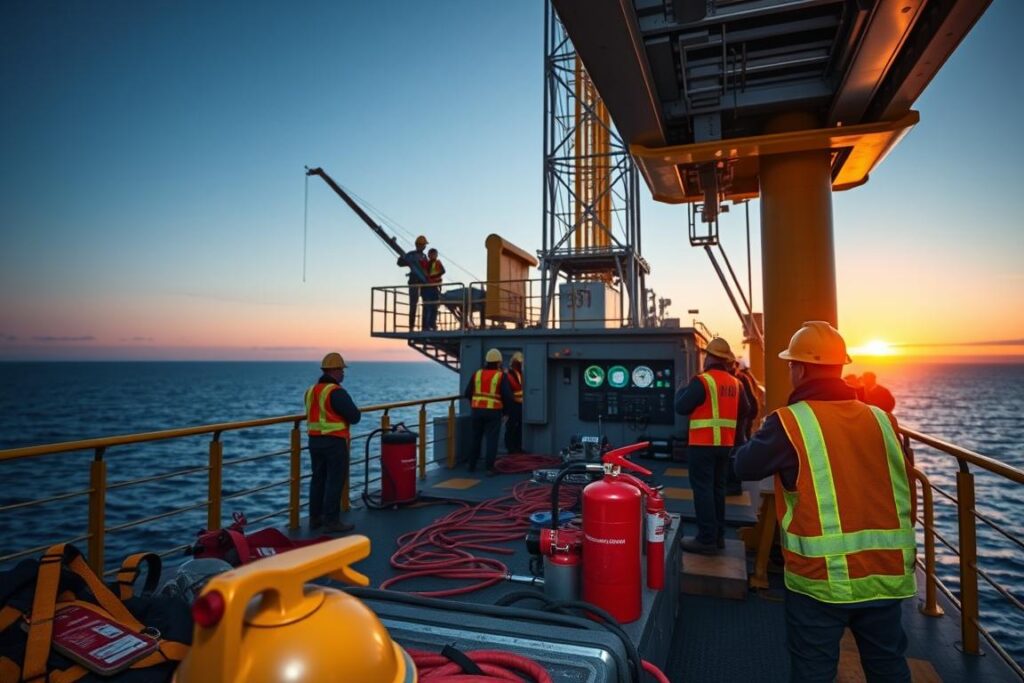Oil rig accidents are very bad. They can cause death, harm the environment, and cost a lot of money. Texas has over 4,000 oil rigs1. The Gulf of Mexico has over 4,000 oil rig platforms, with 25% manned by workers2.
It’s very important to know about oil rig accidents and how to stop them. Workers often get hurt from burns, broken bones, and breathing problems1.
Accidents on oil platforms and during offshore drilling can be very bad. We need good safety steps to stop these accidents. The Jones Act helps workers get help if they get hurt because of their job1.
Safety rules are very important. Breaking them can lead to serious problems like injuries, sickness, fires, explosions, and even death2.
Overview of Oil Rig Accidents
Oil rig accidents are a big worry for the oil and gas world. They can hurt people, the environment, and the economy. Keeping equipment in good shape and checking it often is key to avoiding accidents2.
Key Takeaways
- Understanding oil rig accidents is key to stopping them
- Good safety steps can lower accident risks
- The Jones Act protects injured maritime workers1
- Breaking safety rules can lead to big problems2
- Regular checks and upkeep are vital to avoid accidents2
- Oil rig accidents can have huge environmental and economic effects
Overview of Oil Rig Accidents
Oil rig accidents can be very bad. They can cause death, harm the environment, and cost a lot of money. Looking at the numbers helps us understand the problem better.
The Santa Barbara Oil Spill in January 1969 spilled about 3 million gallons of oil. It was the biggest spill in U.S. history until the Exxon Valdez3. The Alexander L. Kielland disaster on March 27, 1980, killed 123 workers out of 212. It was one of the deadliest oil rig accidents3.
The Piper Alpha disaster on July 6, 1988, was very sad. Over 160 workers died, including 165 crew members and 2 rescue team members4.
Accidents on oil rigs can happen for many reasons. Things like equipment failure, human mistakes, and bad weather can cause problems. To avoid accidents, we need to keep equipment in good shape, train workers well, and follow safety rules. This is why oil rig safety tips and prevention of oil rig accidents are so important. The industry has made progress, but there’s more to do3.
Some big reasons for oil rig accidents include:
- Equipment failure, like pump breaks or pipeline leaks
- Human mistakes, like not knowing how to do a job right
- Bad weather or natural disasters
By fixing these problems and using safety measures, we can make oil rigs safer. Oil rig safety tips and prevention of oil rig accidents are key to keeping workers safe4.
https://www.youtube.com/watch?v=1i8k-ya-MEE
Safety Measures in the Oil Industry
The oil industry is very risky. It needs strict safety rules to avoid accidents. Oil rig safety regulations help keep workers safe from dangers like being hit or caught. These dangers cause 60% of deaths in the oil and gas sector5.
Checking equipment regularly is key. It helps find and fix problems early. This stops big issues later on.
Training is very important. It teaches workers how to do their jobs safely. They learn about causes of oil rig accidents and how to stop them. They also learn about emergency responses and oil rig injury claims6.
By focusing on safety, the oil industry can make work safer. This reduces the chance of accidents. It also keeps workers safe and helps the industry’s image56.
Some important safety steps include:
- Regular equipment checks
- Training for workers
- Emergency plans
- Watching for dangerous gases like H2S

Steps to Prevent Oil Rig Accidents
To stop oil rig accidents, safety must come first. Companies should use a detailed7 safety plan. This plan helps set up rules and steps to lower risks.
It’s also key to make a8 safe work culture. Workers need7 good training and8 clear talks from bosses. This helps avoid accidents.
Using8 new tech and automation makes oil rigs safer9. Keeping an eye on things and9 checking for dangers often is vital. These steps help keep workers, nature, and profits safe.
FAQ
What are the common causes of oil rig accidents?
Oil rig accidents often happen because of equipment failure, human mistakes, and bad weather. Equipment failure is a big reason. Human errors like not knowing how to do a job, being too tired, and making bad choices also matter a lot. Bad weather can make things worse.
How can human error contribute to oil rig accidents?
Human mistakes are a big problem in oil rig accidents. Things like not being trained well, being too tired, and making bad choices are common. Making sure workers are well-trained and not too tired can help.
What are the key safety measures in the oil industry?
Important safety steps in the oil industry include:
– Training workers so they know how to do their jobs safely
– Checking equipment often to find and fix problems early
– Having plans ready for emergencies
How can a safety management system help prevent oil rig accidents?
A safety management system is key to stopping oil rig accidents. It gives a plan for handling safety risks and following rules. It makes sure safety is everyone’s main focus.
What role does technology and automation play in preventing oil rig accidents?
Technology and automation help stop oil rig accidents by watching things closely and alerting to problems. This lets workers fix issues before they get worse. Always watching and checking for safety risks is also important.
Source Links
- Understanding Offshore Oil Rig Accidents – Abraham, Watkins, Nichols, Agosto, Aziz & Stogner – https://abrahamwatkins.com/blog/2024/05/understanding-offshore-oil-rig-accidents/
- Arnold & Itkin – https://www.arnolditkin.com/oil-rig-explosions/safety-on-oil-rigs/
- Arnold & Itkin – https://www.arnolditkin.com/oil-rig-explosions/major-oil-rig-disasters/
- Largest Offshore Oil Rig Disasters in History – https://www.houstoninjurylawyer.com/offshore-oil-rig-disasters/
- Oil Rig Hazards – Safety Management – https://www.identecsolutions.com/news/oil-rig-hazards-safety-management
- Oil and Gas Rig Safety – HSI – https://hsi.com/blog/oil-and-gas-rig-safety
- What Are the Best Ways to Prevent Oil Rig Accidents? – https://www.barneslawfirm.com/what-are-the-best-ways-to-prevent-oil-rig-accidents/
- Preventing Offshore Oil Rig Accidents – https://www.zehllaw.com/preventing-offshore-oil-rig-accidents/
- Understanding Oil Rig Injuries – Causes, Consequences, and Preventive Measures – Esimtech – https://www.esimtech.com/understanding-oil-rig-injuries-causes-consequences-and-preventive-measures.html
